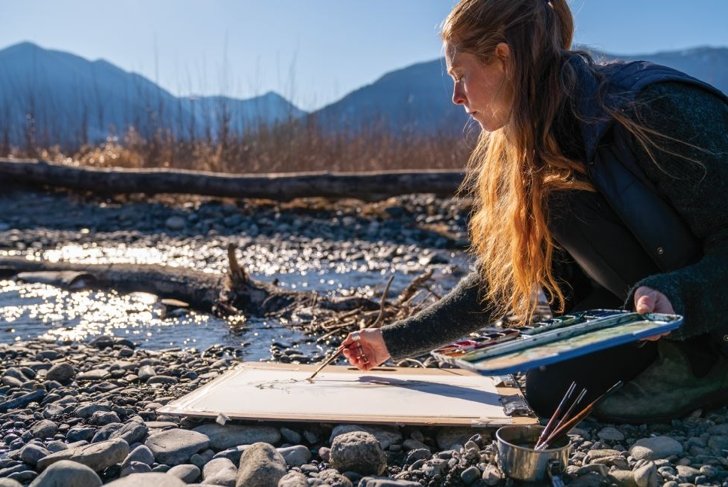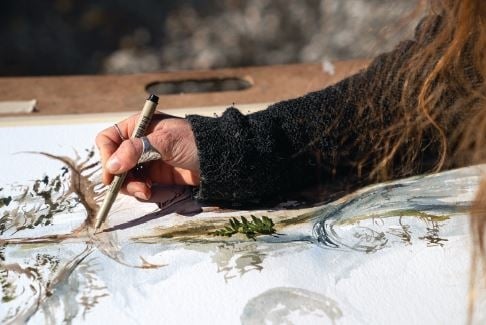
With the onset of long summer days, it’s the perfect time to take up a new hobby. Take some inspiration from bold, innovative women artists from British Columbia who are using natural materials to catalyze conversations around honouring our environment.
There’s a salmon on the beach. But it isn’t made of flesh and bone: instead, rows of luminescent, hollowed-out mussel shells shape its hooked jaw. Cracked sea urchins crest across its dorsal fin, curving into a verdant tail of moss and fern. This piece of ephemeral art, created by visual artist Alana Hansen on the remote shores of Cox Island in Haida Gwaii, seeks to remind us that everything is intertwined.
The art-environment connection
Hansen first became interested in the connection between art and the environment while finishing her degree in global resource systems at the University of British Columbia. Although she had never undertaken any formal art training, art became a way for her to conceptualize what she was learning in class. What started as doodles in the margins of her notebook soon morphed into watercolour maps of the British Columbia coastline integrated into the bodies of salmon, eagles, and orcas, or forests painted onto driftwood.
Time spent living and working in Haida Gwaii particularly influenced her, and she fell in love with ephemeral art—impermanent art pieces created by conscientiously pulling together elements of the landscape, such as fallen leaves, washed-up seaweed, and seashells. Hansen has left these pieces on beaches, by streams, and even on the trails of VanDusen Botanical Gardens, much to the delight of unsuspecting visitors.
“I have some sort of dream, or vision, of connecting different elements of the environment,” says Hansen about her creative process. “I’ll walk into the forest and see a fern—I’ll challenge myself to be curious and think, ‘What’s the bigger picture here?’”

Get inspired
Taking up an art practice is a great way to disconnect from the stress of daily life, as well as to become more in tune with your surroundings. Numerous studies have shown that art therapy can decrease anxiety, boost mood, and improve quality of life.
However, conventional art materials often contain harmful chemicals and compounds. For example, some oil-based and acrylic paints, felt-tip permanent markers, and glues are thought to release toxic vapours, while inhaling powdered materials such as clay and aerosol may trigger asthma, allergies, and headaches—particularly for children. Take inspiration from talented Canadian artists who are championing the use of sustainable materials.
Working with Mother Nature
Rebecca Graham and Jaymie Johnson are two West Coast artists and educators affiliated with the BC-based EartHand Gleaners Society, which works to engage communities in environmental art projects. They use a range of natural elements in their work, such as salmon skin for leather products, and even make use of invasive species such as Himalayan blackberry and English ivy
for weaving.
If you’re looking to forage for natural materials, Graham and Johnson recommend harvesting respectfully and mindfully from a place with which you have a pre-existing relationship. Graham, for example, chooses to use only what’s available in the city, such as green waste from gardens. “You don’t know how foraging will impact the land over time,” Graham says.

Naturally colourful
Solar dyeing is a simple, sustainable way to create natural dye. You can use dyestuffs such as onion skin and blackberries to create vibrant colour, with little more than a Mason jar, natural fibres, a mordant, and some sunshine.
Look online for how-to guides and videos on solar dyeing—the Saskatchewan Craft Council, for example, provides a helpful and concise explanation of the process.
Engaging communities
EartHand Gleaners hosts regular workshops where participants learn to process linen, harvest seasonal fibres, use natural dyes, and even work with flint.
Public projects are also a fundamental aspect of their work, such as a community-engaged project Johnson assisted with in a former industrial area of Richmond, BC, in 2015. The public was invited to turn invasive Himalayan blackberry into rope, which was knotted into large sculptures resembling butterfly nets and installed in trees as part of a larger initiative to revitalize native bee populations.
“Engaging the community with environmental art is an entry point into taking action,” says Johnson. “It fosters hope—otherwise it would be too easy to feel powerless against or apathetic toward environmental issues.”
Graham agrees. “I want people to feel like they’re coming in contact with the natural world in a way that is deeper than wallpaper,” she says. “If they can begin to approach a sense of reverence, that nature is where it begins and ends, that’s what we need.”
Forging new connections
According to Johnson, art that truly shows respect for the environment is inherently collaborative. When you work with natural materials, you need to collaborate with the weather, seasons, and plants; if you’re using recycled materials, you need to collaborate with other people; and if you’re engaging the community, you need the support of the public, professionals, and Canada’s host nations.
“In my experience, collaboration is extremely important in deepening our relationships to a place, and connections to other beings that share that place,” Johnson says. “This is the foundation of a sustainable society.”
Artful Healing
In a study examining self-esteem in seniors, art therapy resulted in significant improvements in self-esteem.
Start your own practice
To get started, Johnson recommends trying out weekly observational drawing—for example, drawing one plant for an entire season. It’s a great way to build and nourish a relationship with your surroundings, and you can do it with the most sustainable materials you have, such as natural ink, charcoal, or pencil.
Of course, eco-friendly materials might not be accessible for all artists right off the bat, so Graham suggests a simple litmus test to determine what you want to work with. “Ask yourself, would I eat something grown in dirt that contains remnants of that? For example, I wouldn’t want to eat food grown where acrylic paint was composted.”
Hansen also advises upcycling old or unused materials and reaching out to other artists to share their supplies. She works predominantly in watercolour, but paints outside whenever possible, often incorporating natural elements into her work. Last autumn, she used water from a nearby river to infuse her pieces with what she terms “life energy”—and a faint whiff of spawning salmon.
For Hansen, what matters above all else is your desire to care for and cherish our natural environment. “Take something that might not be typical and find the magic in the process, not the end result,” she says. “That’s where you can truly lose yourself.”

Sustainable art supply stores:
- Maiwa, Vancouver and online: offers natural fibres and dyes
- Urban Source, Vancouver: collects alternative art materials from more than 100 different local industries
- Kama Pigments, Montreal and online: specializes in a range of eco-friendly artists’ materials
Respecting the traditional stewards of the land
When foraging for natural materials, it’s important to show respect for Canada’s host nations, who have maintained deep relationships to the land for thousands of years. The “four Rs” are the place to start: Respect, Relevance, Reciprocity, and Responsibility. For example, to practise reciprocity, visit a site not just to take away, but also to give something back—even if it’s a simple hello. To show respect, enjoy a silent moment of gratitude, or even exchange a lock of hair.
To find out more, get involved with Indigenous advocacy groups in your local community, and keep an eye out for relevant workshops or panel discussions.
Creating outside the box
Here are some other footprint-light art forms you may not have thought of taking up.
- Dance—both an art form and a form of recreation, dancing allows you to tell a story, set a mood, or express an emotion.
- Journalling—a more private form of creative expression, journalling can help you manage anxiety, cope with stress, and practise positive self-talk.
- Photography—check out your local flea market for a second-hand camera that would otherwise end up in a landfill.
A former alive editor, Isabela Vera has travelled to five continents but will always feel most at home on the foggy shores of the Pacific Northwest.



